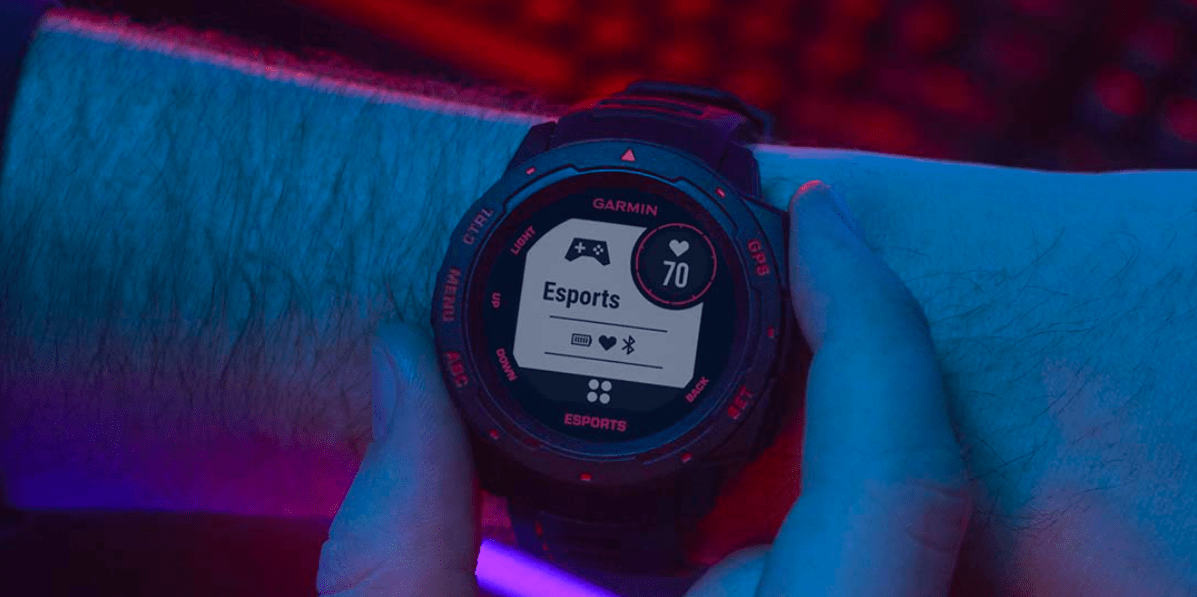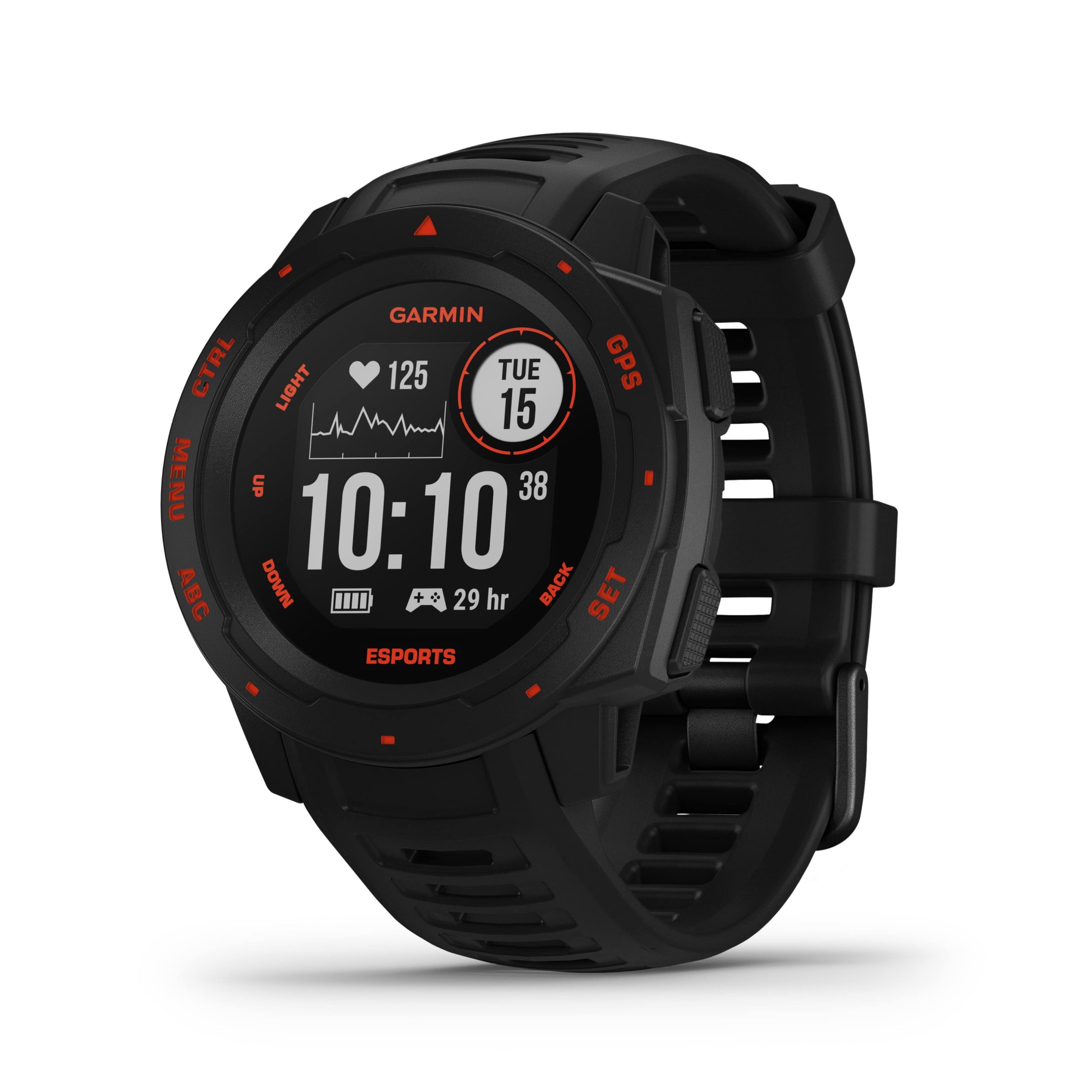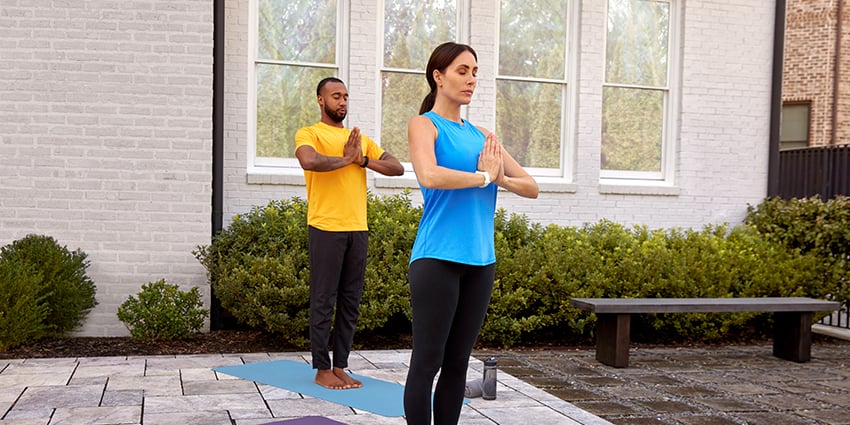
Using Garmin Smartwatch Health Monitoring to Improve Esports Performance
Written by Rehan Nana
A healthy body is a healthy mind. Garmin fēnix 6 and Instinct smartwatches could improve both for esports players.
If you would’ve asked me a week ago if I would feel compelled to write a blog on the importance of competitive esports health training and how Garmin Instinct® and fēnix® health monitoring can help improve esports performance, I would’ve told you there was probably a better chance of me becoming, well, a competitive esports player. To be upfront, I’m not an esports enthusiast. Chiefly, because I am horrible at esports. The last time I picked up a controller was in college to play Halo and I got beat. Very badly, as I recall.
Then someone forwarded me an article, and I fell down a rabbit hole. A giant, seemingly endless rabbit hole burrowed in the new frontier of esports. What I found so fascinating about this article was the demanding nature of esports and the parallels esports have to traditional sports.
The article, written by Jake Middleton of Adamas Esports, discussed the taxing physical and mental aspects these athletes endure at a competitive and professional level and the increased importance of physical training. After a lengthy phone call with Jake, and reading more on the subject, I started to understand how physical training for esports players can help lead to improved performance.
At surface level to non-gamers, it may seem counterintuitive that gamers could benefit from physical training but consider the following:
- The average career for a professional esports player is just a few of years, roughly the same as a U.S. football player’s average career of 3.3 years. According to some, burnout is a major contributing factor.
- During competitive play, heart rates can reach 160-180 beats per minute (bpm). Here is a video of an individual setting a world record; his heart rate gets to 172 bpm. NASCAR drivers have heart rates from 120-150 bpm, by the way.
- Esports gamers face 51 different stress factors during competition, which is on par with other traditional sports.
- Some competitive players may only sleep 4 hours a day.
- Competitive players are increasingly facing repetitive motion injuries.
The above is by no means a critique on the nature of esports. Instead, it showcases the toll that this new breed of professional athlete faces is indeed great.
So, what can be done?
If we understand and accept the demanding physical and mental nature of esports, then we should consider that the pillars of improvement with traditional sports training should hold true with esports athletes. Increased physical fitness leads to increased physical performance. Because esports are based largely in cognitive performance, the traditional mantra of “A healthy body is a healthy mind” may be even more important.
Health monitoring features on the Garmin Instinct and fēnix watches are used by top athletes across the world. By tracking, analyzing and making necessary adjustments in their lifestyles based on data provided by their Instinct or fēnix smartwatches, these athletes can shape how their bodies react to the physical and mental pressures of their sports.
Using the same health monitoring technology as other top athletes, esports players can monitor their health in order to help improve their overall esports performance and health in the process.
While there are many features that esports players may find beneficial in the Garmin smartwatches, below are a few that might benefit their physical well-being, and in turn, their potential performance.
Author’s Note: Because I mentioned I am not a gamer, I’ve brought in two experts to help me out further explain these concepts, Jake Middleton of Adamas Esports and Herman Bonner of FirstBeat.
Heart Rate Monitoring
“We know in traditional sports like running that a lower heart rate at a given intensity is better for performance. No research on this exists currently in esports but we can hypothesize that a lower heart during intense cognitive load may benefit performance and certainly player longevity over time,” said Jake Middleton, Adamas Esports performance coach.
We understand that an increased heart rate leads to increased stress, increased stress exacts a physical toll on the body and an increased physical toll can lead to decreased physical and mental stamina. So how can we improve upon this?
One simple way to improve is to decrease your overall resting heart rate through increased physical activity and exercise, which decreases your stress levels.
“Anyone who has stood up to speak or perform in front of an audience can attest to a relationship between heart rate and stress. A racing pulse, pumping more blood through your veins than your current level of physical activity demands, is a good indicator that you are under stress, but that’s only part of the picture. Changes in the length of time between consecutive heart beats supply further information, critical for understanding your body’s response to challenges. Notably, as your fitness level improves your body is under less pressure to meet the basic needs of life,” said Hermann Bonner, author at FirstBeat.
When paired with Instinct or fēnix, the free Garmin Connect™ app stores long-term data and trends so players can monitor, improve and continue to make adjustments as needed in their physical regiment. The engine that drives many of the health monitoring features in Garmin’s Instinct and fēnix watches is provided by FirstBeat, which provides advanced variable heart rate monitoring.
According to FirstBeat, “Improving your fitness is like putting a bigger engine into your car. Keeping up with the demands of daily life and activities requires a smaller percentage of your total capacity. It’s like getting similar performance at lower rpms. Your routines become easier, producing less stress and strain on your body’s systems. When it’s time to perform, you are fresher and have more in reserve. The Firstbeat analytics engine built into your Garmin watch helps track your stress levels with the help of machine learning. Changes in the length of time between consecutive heart beats (HRV) are analyzed and transformed into a window through which activity occurring in your autonomic nervous system can be seen. This means that the interplay between fight-or-flight (sympathetic) and the rest-and-digest (parasympathetic) systems becomes visible, as they work in tandem, responding to the challenges of life and environment.”
Like any other athlete, in order to decrease heart rate, esports players can increase physical activity to lower heart rate over time. What this means for competition is simple: A lower heart rate during play can lead to overall decreased physical demand and stress on the body, potentially allowing for longer, more focused competitive play.
Stress Monitoring
“High levels of stress consistently over time without sufficient recovery can lead to physiological and psychological issues. In traditional sports this is termed overtraining, and it occurs in the exact same way in esports if players and teams don’t effectively manage their stress in-game and outside of it,” said Middleton.
Garmin Instinct and fēnix smartwatches track stress and report data in 3-minute averages. Being able to monitor stress this closely during play and outside of competition allows for two opportunities.
First, during competition, if individuals notice their stress levels increasing, they can take a mental check and try to make adjustments through stress management techniques, which can be something as simple as taking a few deep breaths.
Second, using cumulative stress monitoring data on the Garmin Connect app outside of play also allows for a holistic approach to stress management. If individuals notice their stress levels running at continually high levels, they may find something as simple as getting outside for a walk or other stress coping mechanism beneficial. These efforts could pay dividends during competitive play.
To scientifically measure and track stress, the Garmin watches rely on the Firstbeat analytics to interpret how your heart is beating from one moment to the next. Validated and improved over the course of a decade, Firstbeat’s stress measurement analysis has been utilized in over 200,000 Lifestyle Assessments conducted by health, fitness and lifestyle professionals.
“When it comes to being at your best, one-size-fits-all strategies typically don’t translate into competitive advantages. Tracking your own stress levels throughout the day, seeing what affects you, opens the door for better training and lifestyle management approaches based on what works for you personally,” said Bonner. “This kind of data lets you experiment, vary your routines, and find your own solutions. Having trouble with overnight recovery? Try switching over to a talk show instead of watching prestige dramas on HBO or binge-watching Netflix. You can even turn off the TV entirely to see how indulging in a book will influence your stress patterns.”
When it comes to stress, little things make a big difference. Direct feedback based on how you experience the world at a physiological level makes it easier to find problem areas and make the right changes. The continuous nature of all-day stress monitoring* is a real game changer in the struggle to ensure that lifestyle changes made are lifestyle changes kept.
Sleep Monitoring
“Sleep has one of the biggest impacts on mental and physical performance. When players themselves and staff are able to learn more about their sleep patterns from objective data, it helps them improve sleep strategies and make healthy behavior changes, which can lead to improved performance,” said Middleton.
We’ve all been there, waking up groggy and just not feeling “on your game.” Until recently, we chalked it up to the Sandman taking a night off. Now with advanced sleep monitoring* in compatible Garmin smartwatches, users can track and furhter understand sleep patterns in order to make changes that can lead to further sleep “recovery.”
By leveraging the optical heart rate sensor on your watch, the Instinct or fēnix can now measure heart rate variability, combined with the accelerometer, you can determine when you fall asleep, when you wake up and what level of sleep you are in — light, deep or REM sleep. Using this and other sleep tracking measurements on Garmin smartwatches not only allows users to know how long they slept, but also how well they slept by assigning a sleep score of 1-100.
As FirstBeat points out, “To be successful, you don’t just need to know how long you slept, you need to know whether you’re ready to take on the world. This means knowing your body has the resources and energy it needs to power through the day. Additionally, you can gain an understanding of how your body responds during the night and identify and manage factors that reduce the restorative power of your sleep. Knowing your batteries are charged lets you take on challenges with confidence, ready to bounce back stronger than before.”
For the average person, having a more comprehensive view of their sleep quantity and quality can lead to increased confidence to tackle another day at the office. For esports players, it could mean increased confidence during competitive play.
Garmin Body Battery™ Monitoring
One of the fastest and easiest ways an esports athlete can measure their overall health is through the Garmin smartwatch Body Battery feature. Body Battery takes a comprehensive look at key health metrics and combines them into an easily digestible “at-a-glance” metric to determine how ready they are to take on the day.
Body Battery uses a combination of heart rate variability, stress and activity to estimate the user’s energy reserves throughout the day. It records and displays a number from 1 to 100 that represents the individual’s energy level. The higher the number, the more energy the user should have to complete tasks and activities. A lower number may indicate it is time to conserve energy. The unique aspect of Body Battery is that it is a cumulative metric that builds a picture of a user’s energy over hours and days.
Why is this important? In short, it helps you manage your day. When the number is high, it should mean you have enough energy for a workout or exercise. Conversely, when the value is low, it may be a good idea to conserve energyand rest. It can also be used to learn how your body reacts to various situations and stimuli. For example, if the Body Battery shows a low number in the morning, you may be able to look at the past few days of cumulative measurements to identify what may have been the cause.
Using Body Battery to know when to stop and recharge may give players a competitive advantage in order to gain an edge. To learn more about Body Battery, visit “How Garmin’s Body Battery Can Teach You to Thrive.”
The Future of Wearable Technology in Esports
“For the future of esports training, having physiological data such as heart rate, stress, sleep and more is going to allow players and teams to adopt healthier training strategies and behaviors that can lead to improved play and a more sustainable training structure in esports,” said Middleton.
While many of us may not know it, we are witnessing the growth of what very well may become (if it hasn’t already) the “next big thing” in sports. It seems that as a sport matures, so does the increased focus on players’ physical well-being. Just as football went from no helmets to leather helmets to advanced modern helmets, asthe popularity of esports continues to grow, the use of personal technological health monitoring will help give players a competitive advantage in play. It can also lead to an increased health awareness in their lives both on and off the field of competitive esports.
For those of you who want to play and feel better, the choice is in your hands.
Or, more appropriately, the choice is on your wrist.
*See Garmin.com/ataccuracy.





